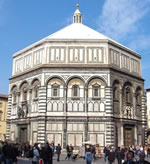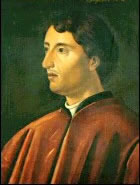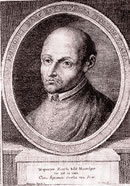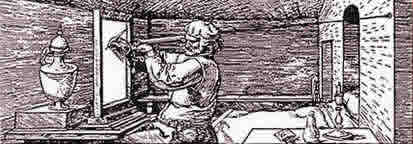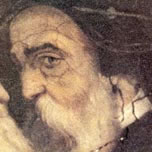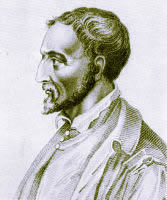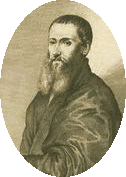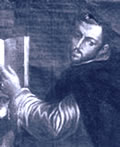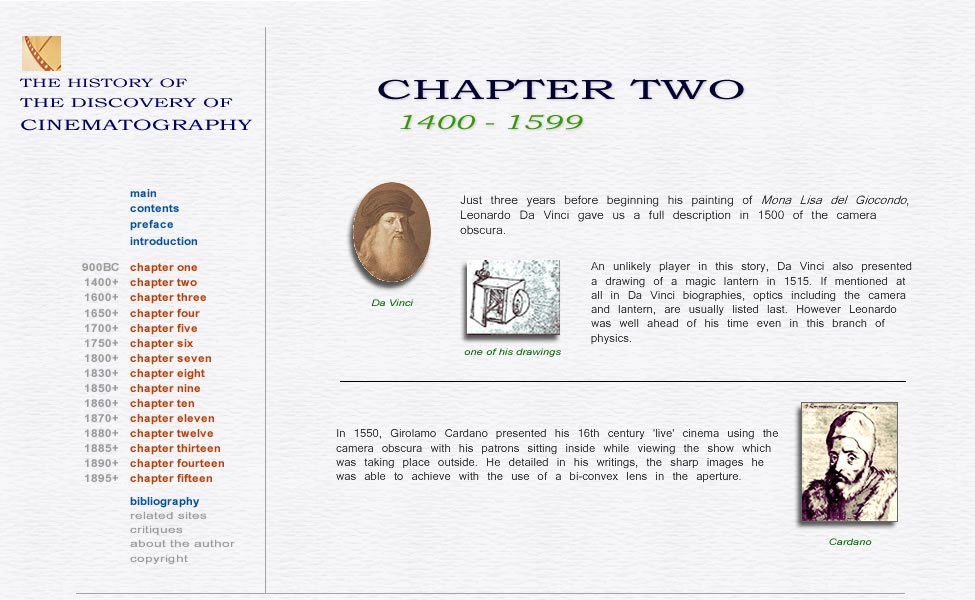 |
| |
|
|
|
| |
|
|
|
|
| |
| |
ca.
1420
JOHANNES DE FONTANA ( - )
What
appears to be the earliest-ever illustration of the camera obscura
is found in a book by Fontana in 1420. The drawing shows a nun
holding a vertically shaped camera with an image on the inside.
Historians and commentators routinely speak of this illustration
as a lantern, however the apparatus held is nothing like a lantern.
The camera obscura contains the image and the lantern
projects it. In this drawing by Fontana we see the image
within the held object. The subject image does not appear
to be projected, even when viewing the entire image. One aspect
of the supposed image (devilish character) is interesting however;
the lantern very early became an instrument to instill fear in
its viewers. Diabolic and demonic themes were common. In France
for instance, the lantern became known as the Lanterne de Peur
or "Lantern of Fear". To date,
all other interests have only described the camera with reference
to it's appearance but with no actual drawing or illustration.
I am not convinced this is a lantern or a drawing of a lantern,
however, could this drawing of Fontana's be the same as referenced
by Siegfried Zielinski in his piece on Cinema Archaeology
when he states regarding the magic lantern....... |
"One
of the earliest, around 1420, had a particularly striking feature:
the diabolical element was very definitely imagined as feminine.
The projectionist, who held the lantern with a taper in his hand,
wore oriental clothes (possibly a reference to the original inventors
of the magic lantern). The drawing of the lantern was not exact;
the apparatus is depicted around the image . . . . .."
(Siegfried Zielinski,
Media Archaeology, #5, A companion piece ).
Johannes de Fontana sketch (above
left) of his camera obscura from 1420 (Indebtedness to Loek Raemakers,
Rotterdam) RETURN TO
INTRODUCTION |
|
|
| |
|
|
| |
|
|
| |
|
|
| |
|
|
| |
1425 FILLIPO BRUNELLESCHI (1377
- 1446) |
|
|
| |
Brunelleschi is believed
to have either built or used a camera obscura in this year. Little is
know of him. Shigeru Tsuji's 'Brunelleschi And The Camera Obscura: The
Discovery of Pictorial Perspective', Art History vol.13, 1990, pp. 276-292
makes this claim. |
|
| |
|
|
| |
| 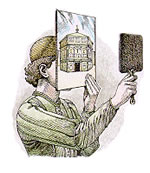
|
Besides
his use of the camera obscura, Brunelleschi also developed a 'peep
show' or Perspective Viewer which provided a
3D image and incredible depth. Brunelleschi's work as a sculptor,
architect, gold and silversmith advanced greatly the art of perspective
painting and interactive art.
His Viewer (left)
was created using a glass plate on which a silver background was
painted. Overlying this was painted (in this example-left) an
image of the Baptistry in Florence. At the vanishing point of
the image Brunelleschi placed a hole for the eye to see through.
Using a mirror, and turning the plate around, the observer would
see the image reflected on the mirror, with the sky and clouds
reflected off the silver base. This ingenius use of the mirror
and silver added to the depth of the 'peep show' image. |
|
| Source: Adventures
In Cybersound |
His mathematical work can be
said to have led to an understanding of what linear perspective
is. |
Source:
Georges Jansoone |
| |
The Baptistry in Florence today
(right) as seen in the Perspective Viewer in AD 1425. |
|
| |
|
|
|
|
| |
|
| |
|
|
|
|
|
|
| |
|
|
| |
1457
LEON BATTISTA ALBERTI (1404 - 1472)
Vasari, in his
'Lives of the Painters, Sculptors and Architects' tells
us of Alberti; "Leon Battista made
a discovery for representing landscapes and for diminishing
and enlarging figures by means of an instrument, all good inventions
useful to art." This instrument was actually Alberti's
"intersector" (a cousin to the camera lucida), and not a camera
obscura. Alberti describes this technique in his 'Treatise
on Painting'.
Vasari's work also
contains details of a show box (Vite de' Piu Eccellenti
Architetti E. Scultori, Vasari, G., Milan, Italy, 1809, vol.5,
p81) where painted pictures on transparent bases were illuminated
from behind by candles. This description closely resembles (and
pre-dates) the magic lanterns of Drebbel and Kircher.
While Alberti was describing
his showbox and intersector to the world, Guttenberg was printing
the Bible. |
|
| |
Leon
Battista Alberti |
|
|
| |
|
|
|
| |
|
|
| |
|
|
|
| |
|
|
|
| |
AUTHOR'S NOTE:
During the 15th Century, Gainsborough
painted (for Alberti?) many landscapes on glass and made similar apparatus
(show boxes) to that of Alberti. These boxes were wooden and had peepholes
at one side. The opposite end was open and had the glass-painted slide
inserted and lit from behind by candles. A Gainsborough showbox is at
the Victoria and Albert
Museum, London. |
|
| |
|
|
| |
|
|
|
| |
1488
GIORGIO PURBACHIUS (GEORG PAUERBACH) (1423 - 1461) |
|
|
| |
'The Theoriques
of Purbachius' is published in Venice, 27 years after the death
of the author. |
|
| |
|
|
| |
|
|
|
|
|
|
| |
|
|
| |
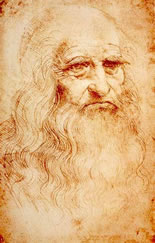 |
1500
LEONARDO DI SER PIERO DA VINCI (1452 -1519)
Vinci gives the fullest
description known to date on the camera obscura. Due to Vinci's
special form of writing (written backwards called Mirror Writing),
his work on the camera would not become common knowledge in
the civilized world for almost three centuries. His
'Codex Atlanticus' (Vinci, Leonardo, Ambrosian
Library, Milan, Italy, Recto A of Folio 337), and 'Manuscript
D' (Manuscript D, Vinci, Leonardo, Institut de France, Paris,
Folio 8) both give detailed accounts of the camera obscura
effect, observations, diagrams and explanations of it's principle.
In all of Da Vinci's works there are 270 separate diagrams of
the camera obscura. These descriptions would remain unknown
of for 297 years when Professor Venturi would decipher and publish
them in 1797. SEE VENTURI
While Da Vinci works,
Henry VIII ascends the English throne (1503), and Michelangelo
paints the ceiling of the Sistine Chapel (1504).
Leonardo
Da Vinci 1452-1519, 'Self Portrait' (left)
|
| |
|
| |
|
In
writng on the eye, Vinci incorporates the camera obscura effect
seen through the pinole. He writes;
"O marvellous, O stupendous
necessity, thou with supreme reason compellest all effects to
be the direct result of their causes; and by a supreme and irrevocable
law every natural action obeys thee by the shortest possible
process. Who would believe that so small a space could contain
the images of all the universe? O mighty process! What talent
can avail to penetrate a nature such as these? What tongue will
it be that can unfold so great a wonder? Verily none! This it
is that guides the human discourse to the considering of divine
things. Here the forms, here the colours, here all the images
of every part of the universe are contracted to a point. What
point is so marvellous? O wonderful, O stupendous necessity---by
thy law thou constrainest every effect to be the direct result
of its cause by the shortest path. These are miracles...forms
already lost, mingled together in so small a space it can recreate
and recompense by expansion. Describe in thy anatomy what proportion
there is between diameters of all the lenses in the eye and
the distance from these to the crystalline lens." |
| |
|
| |
|
| |
|
| |
1515
LEONARDO DI SER PIERO DA VINCI (1452 - 1519)
Vinci
wrote a manuscript ‚€˜Treatise on Painting‚€™ covering
various principles within optics. It will be published in Milan
in 1589 and later in Paris in 1651. |
| |
|
|
|
| |
Approximately one hundred
and forty years prior to Kircher's lantern, Leonardo gave us this drawing
(lower left) of a lantern showing clearly a condensing lens,
candle and chimney. None of Leonardo's writings indicate any hint of him
actually projecting images, however this illustration from the master
strongly suggests a figure of some type between the candle and lens. |
|
| |
|
|
| |
|
|
| |
|
|
|
| |
|
|
|
| |
1520
FRANCISCUS MAUROLYCUS (1494 - 1575) |
|
|
| |
This astronomer and mathematician
writes in his 'De Subtilitate', on light, theatres, and
light theatres. He names Da Vinci, Albertus Magnus and Pliny in this work. |
|
| |
|
|
|
| |
|
|
|
| |
|
|
| |
|
|
| |
1521
FRANCISCUS MAUROLYCUS (1494 - 1575)
A Jesuit priest, Maurolycus
finishes his 'Theoremata De Lumine Et Umbra Ad Perspectivam'
(1611, Naples, 1613, Leyden) explaining how
to build a microscope and in proposition 20 of the book writes,
"an object's shadow can be converted
and projected."
He also notes that
using the pinhole image effect, a shadow moves the opposite
way of the object, a claim already observed and documented by
the Chinese 2000 years prior.
This work is not published
until 1611, after his death. Maurolycus also studied and made
references to rainbows and how light refraction affected them.
|
|
| |
Franciscus
Maurolycus |
|
|
| |
|
|
|
| |
|
|
| |
| |
|
|
|
| |
1521
CAESARE CAESARIANO (1483 - 1543) |
|
|
| |
What
could be the earliest published description of the camera obscura (Vinci's
works were not published until 1797 when deciphered by Venturi) is found
in Vitruvius's 'Treatise On Architecture' (10 volumes,
Trans. by Caesare Caesariano, Como, Italy, 1521, Book 1, Leaf 23, verso).
Caesariano was a student under Vinci and through the work of Vitruvius,
describes a passage detailing an experiment by an unknown Benedictine
monk, Papnutio, or Paunce. The entry tells of the use of a cone-shaped
hole (or tube) in the wall, in order to allow more light and therefore
a larger image on the opposite white wall. A concave glass screen is also
mentioned being placed in the hole of a wall in a darkened room. Caesariano
wrote;
"Cut
a circular concavity about two inches in diameter in a piece of wood about
four or six inches in size, then place in the centre of the concavity
a small and very short tube [spectaculum] or aperture, which is also called
a sight. If you fix this properly in a panel of a door or in a window
shutter, closed so that no light can enter, and if you have a piece of
white paper or other material upon which [the images of] everything passing
through the aperture may be received, you will see everything on the earth
and in the sky with their colours and forms, according to the conical
shape [piramide] of the hole."
(This
quote taken directly from the work of Helmut Gernsheim, The History of
the Camera Obscura From the Earliest Use of the Camera Obscura in the
Eleventh Century Up To 1914, p4,5).
Like
the style of Leonardo Da Vinci, Papnutio gives exact dimensions in his
account of the camera obscura. Unfortunately, Caesariano does not give
dates of the experiment. Thirty years later, Porta will speak of the camera
in astonishingly similar terms and claims for his own the idea of using
lenses under the pretence of "secrets".
Author's Note:All
research to date (including source references) has failed to unearth this
Papnutio,other than the above finding. |
|
|
|
|
|
| |
|
|
| |
|
|
| |
| 1525 |
|
ALBRECHT
DURER (1471 - 1528)
This
German artist made woodcuts of drawing aids, one of which was
his own and published them in his 'Underweysung'
in 1525. His illustrations show telescopic, or sighting tubes
and grids used by the artist.
One of Durer's drawing aids called a 'sighting
tube'. A cord attached to the wall and the tube provided
the artist with a one-eyed view, and a much longer distance in
the viewer, which in turn reduced potential distortion. |
|
|
|
| |
|
|
| |
|
|
| |
|
|
|
| |
|
|
|
| |
1535-1543
FRANCISCUS MAUROLYCUS (1494 - 1575) |
|
|
| |
Maurolycus was a Sicilian
professor of mathematics at Messina. He made references to observing eclipses
without harming the eyes by using a camera obscura in his 'Cosmographia',
(Maurolycus, Venice, Italy, 1543). |
|
| |
|
|
|
| |
|
|
|
| |
|
|
| |
|
|
|
| |
| 1540
BENVENUTO CELLINI (1500 - 1571)
At least a century before
Kircher‚€™s show (which would place it at approximately 1540),
the history of CELLINI provides us with a report on a phantasmagoric-type
show presented at the Coliseum, Rome, documented by many writers
including ROSCOE in his ‚€˜Life Of Benvenuto Cellini‚€™.
On this supposed event,
the writer Samuel Higley wrote in the June 1876 edition of The
Magic Lantern (regarding the work of Kircher but
referring to Cellini); |
|
| Benvenuto
Cellini |
| "There
is every probability that this was the crude kind of optical
arrangement employed by the Sicilian priest whose incantations
in the Colosseum at Rome are so graphically described by the
celebrated Florentine engraver, Benvenuto Cellini. This necromantic
ceremony, he states, lasted above an hour and a half, whereat
legions of fiends seemed to fill that vast amphitheatre. Cellini
seems to have had some knowledge of how these demons were "raised",
as he says that he tried to quell the intense fear and horror
of his companions by telling them that "all these demons are
under us, and what ye see is but smoke and shadow," thus indicating
an optical origin for such frightful visions. A declaration
made by a youth who accompanied Cellini on this occasion further
confirms the conviction that some kind of magic lantern was
employed, for the boy states: "As we are going home to our houses
in the Quarter Branchi, two of the demons whome we had seen
at the Amphitheatre went on before us and leaping and skipping,
sometimes running upon the roofs of the houses, and sometimes
upon the ground." -
Samuel Higley, The Magic Lantern, June 1876, Vol. II, No. 6 |
|
|
| |
Brewster has also quoted this event. |
|
|
| |
|
|
|
| |
|
|
| |
|
|
|
| |
|
|
|
| |
1540 - 1545
ERASMUS REINHOLD (1511 - 1553) |
|
|
| |
This German mathematician
and astronomer made observations of solar eclipses using a pinhole camera,
and explained how to use the camera to view the eclipse. Reinhold tells
of two eclipses that took place in 1544 (a solar eclipse of January 24,
1544 was illustrated and described by Frisius) and 1545. Reinhold's 'Theoricae
Novae Planetarum' of Georg Pauerbach, mentions that not only
can one observe an eclipse, but also "things
in the street." |
|
| |
|
|
|
| |
|
|
| |
|
|
| |
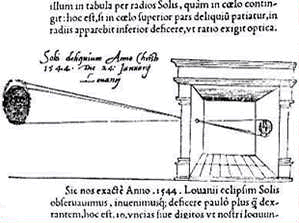 |
1544
REINERUS GEMMA-FRISIUS (1508 - 1555)
A
Dutch mathematician and physician, Gemma-Frisius observes and
illustrates (believed to be the initial account) the eclipse of
January 24, 1544 using the camera obscura. He refers to his mentor's
(Reinhold) commentary on Pauerbach when he says
"we have also observed an eclipse of the sun at Louvain in 1544."
He publishes his illustration in 1545 and titles it 'De
Radio Astronomica Et Geometrico'. (Gemma-Frisius,
Antwerp, 1545, leaf 31).
Reinerus
Gemma-Frisius's illustration (left) of the solar eclipse
he observed in Louvain on January 24, 1544.
|
| He
published 'De Radio Astronomica Et Geometrico'
the next year. This pinhole camera drawing is an excellent illustration
of a camera obscura and the workings of a pinhole image. The inverted
image of the sun and moon is clearly visible on the wall of the
camera. |
|
|
| |
|
|
| |
|
|
|
|
|
|
| |
|
|
|
| |
1550
GIROLAMO CARDANO (1501 - 1576)
Cardano,
a professor of mathematics and a great physician, published in
his book 'De Subtilitate Libri' (XXI, Cardani,
Nurnberg, 1550, Book IV, p107) his makings of a camera obscura
with a diverting spectacle and a very graphic description of darkroom
pictures and their appearances. Cardano appears also to have initiated
the use of a convex lens in the aperture. Cardano was a showman,
and projected wild scenes of the outdoors along with appropriate
sound effects to audiences in the camera obscura. In 1570, Cardano
was accused of heresy, jailed, and lost his right to publish books.
SEE VILLENEUVE
In 1117 Cardano published
De Subtilitate Rerum on other inventions, and natural history.
He traveled throughout Europe and in 1552 treated the Archbishop
of St. Andrews (Scotland) successfully. |
|
| |
Girolamo Cardano
1501-1576 |
|
|
| |
|
|
| |
|
|
| |
|
|
|
| |
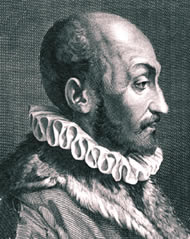 |
1553
- 1558
GIOVANNI BATTISTA DELLA PORTA (1538[35?] - 1615)
Porta gave elaborate details in physics, alchemy, astronomy, magic,
cooking, perfumes, toiletry and optics in his 'Magiae
Naturalis Libri' (III, vol.4, Porta, Naples, Italy,
1558). This first work (also see 1588) by the Neopolitan
scientist Porta, was a popular piece of scientific literature
in the sixteenth century and in book 2, chapter 3, Porta gives
a thorough description of a camera obscura and the images that
one would see. From about this point on, the camera obscura would
become a useful tool to artists.
Giovanni
Battista Della Porta 1538-1615 |
Translated
through the work of Zielinski, Della Porta begins his XVII Book
of the "Magiae Naturalis" with the study of mirrors
by saying "It is also possible, using
flat mirrors, to see things that are happening in far-off places
. . ." (Ch.2, paragraph 4). Chapter VI provides
us with his 'Obscurum Cubiculum' or camera obscura,
where he tells us "how hunting scenes
and battles and other kinds of hocus pocus can be made and performed
in a room. Guest performances, battle fields, games, or what you
will, so clear, distinct, and pretty to see as though it were
taking place before your very eyes,". Porta explains,
"For the image is let into the eye through
the eyeball just as here through the window".
In keeping with the true showmen of this century, Porta continues
to describe the common film of today . . .
"Namely, opposite to the room where you desire to see this, there
must be a large, level space that the sun can shine down upon,
where can be placed all manner of trees, forests, rivers, or mountains
as well as animals, and these can be real or artificial, of wood
or other material... There can be stags, wild boars, rhinoceroses,
elephants, lions and other animals, whatever one wants to be seen;
they can slowly creep out of their corners into the space, and
then the hunter can appear and stage a hunt . . ."
(These quotes (trans. from Latin)
taken directly from the work of Siegfried Zielinski,
Media Archaeology, Cologne, Germany). |
|
|
| |
|
|
| |
|
|
| |
|
|
|
| |
|
|
|
| |
1556
GEORG FABRICIUS (1516 - 1571) |
|
|
| |
This alchemist came upon
horn silver, also known as luna cornea, a semi-transparent compound found
naturally in iron ore in the silver mines of Germany. He found that by
adding a solution of salt and silver nitrate, the metal would turn from
white in the prepared state to black under sunlight. Because of the nature
of alchemy (the false belief that gold exists in all metals) this discovery
was tossed aside. Fabricius would publish a book in this year on these
metals. |
|
| |
|
|
|
| |
|
|
|
| |
|
|
| |
|
|
|
| |
1568
DANIEL BARBARO (1514 - 1570)
This Venetian nobleman
and architect describes the use of a biconvex lens in the camera
obscura in his 'La Practtica Della Perspecttiva'
(Barbaro, Venice, Italy, 1568, ch.5, p192). As did
Porta, Barbaro suggested the use of the camera obscura to the
painter. In describing the use of the convex lens, he shows
that the image is much sharper and can therefore be outlined
by a pen;
"Close
all shutters and doors until no light enters the camera except
through the lens, and opposite hold a piece of paper, which
you move forward and backward until the scene appears in the
sharpest detail. There on the paper you will see the whole view
as it really is, with its distances, its colours and shadows
and motion, the clouds, the water twinkling, the birds flying.
By holding the paper steady you can trace the whole perspective
with a pen, shade it and delicately colour it from nature." |
|
| — Daniel Barbaro,
in his 'La Practtica Della Perspecttiva', 1568, chapter 5, page
192 |
|
|
|
| |
|
|
|
| |
|
|
| |
|
|
|
| |
|
|
|
| |
1571
LEONARD DIGGS (1520 - 1559) & THOMAS DIGGS (1546 - 1595) |
|
|
| |
The senior Leonard and
son Thomas, two mathematicians from London, publish their 'Pantometria'
(A Geometricall Practise Named Pantometria, Diggs, L&T, London, 1571)
and let it be known that they were learned men in convex and concave lenses.
They spoke of the ability to make far objects look nearer. |
|
| |
|
|
|
| |
|
|
|
| |
1572
FREIDRICH RISNER ( - d. 1580) |
|
|
| |
Translates Alhazen's 'Optics'
into Latin. Risner mentions in his own 'Opticae' published
after his death, the camera obscura to reduce and enlarge drawings and
says it can delineate easily and accurately, topographical views. Risner
also relates to the reader the idea of a transportable (camera) apparatus,
and current knowledge on alchemy by the Arabic scientists. |
|
| |
|
|
|
| |
|
|
| |
|
|
| |
|
|
|
| |
1573
IGNATIO (PELLEGRINO RAINALDI) DANTI (1536 - 1586)
Florentine astronomer
and mathematician Danti speaks of using a concave mirror in
a darkened room to "upright"
the image (Danti's Edition Of Euclid's Optics, Florence,
Italy, 1573).
While correcting the vernal
equinox in order to recalibrate deficiencies in the calendar,
Danti used the camera obscura to assist him in determining the
height of the mid-day sun. He accomplished this by placing a
small hole in a window of the church to create his camera. To
complete the project he made two other holes in the wall higher
up the building to allow a line of sunlight to strike the aperture.
|
|
| |
|
|
|
| |
|
|
|
| |
|
|
| |
|
|
|
| |
|
|
|
| |
1575
FRANCISCUS MAUROLYCUS (1494 - 1575) |
|
|
| |
Maurolycus (also see 1520,
1521 and 1535-1543) now concerns himself with light rays and their direction
in the camera. In the year he died, he published 'Photismi De
Lumine Et Umbra' and offered a solution to the age old optical
phenomenon (SEE ARISTOTLE) of why, regardless
of the shape of the aperture (rectangular) does the image of the sun always
appear round or crescent-shaped during an eclipse. He fails to describe
the apparatus used. |
|
| |
|
|
|
| |
|
|
|
| |
1585
GIOVANNI BATTISTA BENEDETTI (1530 - 1590) |
|
|
| |
This Venetian Patrician
wrote in a mathematical treatise entitled 'Diversarum Speculationum
Mathematicarum' (Jo. Batistae Benedicti, Turin, Italy, 1585,
p270) his use of both concave mirror and convex lens to correct the
image. Benedetti spoke of angles and degrees (45) in his treatise along
with the camera obscura. |
|
| |
|
|
|
| |
|
|
|
| |
|
|
| |
|
|
| |
 |
1588
GIOVANNI BATTISTA DELLA PORTA (1538[35?] - 1615)
In
this later version of his 'Magiae Naturalis'
(1st English Trans. Young & Speed, London, 1658, p363, Et
Seq. 2nd Trans., Wright, London, 1669) which is 20 volumes
in length, Porta talks again of the camera obscura at great length
and expands on what he calls his "secrets",
namely, the use of the lens in the aperture (a common practise
to this point in time, as we saw with Benedetti, Barbaro, Cardano
and Papnutio). Chapter VIII of Porta's 17th book of Magiae Naturalis
gives us his visual description of the 'dark room' and the sight
thereof .......
"How an image can be made to appear in the air without either
the mirrors or the form of the thing itself being seen."
The cover
to his 'Magiae Naturalis' (Natural Magic) of
1558. "That by night an image may seem
to hang in a chamber."
- Giovanni Battista Della Porta |
|
|
| |
|
|
| |
|
|
| |
|
|
|
| |
|
|
|
| |
1589
LEONARDO DI SER PIERO DA VINCI (1452 - 1519) |
|
|
| |
Da Vinci's 'Treatise
on Painting' is published in Milan from his posthumous manuscripts.
These writings indicate that art never looks like natural objects seen
by the eyes. He compares paintings to actual sight and claims binocular
vision as the reason. |
|
| |
|
|
|
| |
|
|
|
| |
1593
GIOVANNI BATTISTA DELLA PORTA (1538[35?] - 1615) |
|
|
| |
In a paper published on
refraction called 'De Refractione', Porta compares the
eye to the camera and refers to vision, prisms, colours and optics in
general, including lenses. |
|
| |
|
|
|
| |
|
|
|
| |
| |
|
|
|
| |
|
|
|
| |
|
|
|

|
| |




